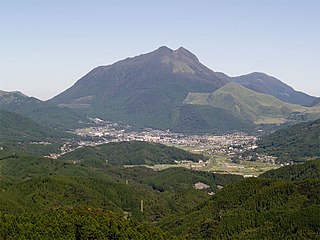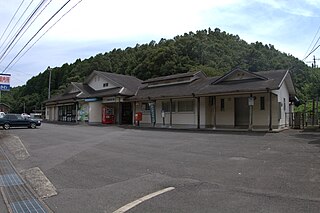
Ōita Prefecture is a prefecture of Japan located on the island of Kyūshū. Ōita Prefecture has a population of 1,136,245 and has a geographic area of 6,340 km2. Ōita Prefecture borders Fukuoka Prefecture to the northwest, Kumamoto Prefecture to the southwest, and Miyazaki Prefecture to the south.

Saiki is a city located in Ōita Prefecture, Japan. As of 31 October 2023, the city had an estimated population of 65,870 in 32921 households, and a population density of 73 persons per km2. The total area of the city is 903.11 km2 (348.69 sq mi), making it the largest city by area in Kyushu.

Takachiho is a town in Nishiusuki District, Miyazaki Prefecture, Japan. As of 1 October 2023, the town has an estimated population of 11,065 in 4865 households, and a population density of 47 persons per km2. The total area of the town is 237.54 square kilometres (91.71 sq mi).
Naoiri was a district located in Ōita Prefecture, Japan.

Kusu is a town located in Kusu District, Ōita Prefecture, Japan. As of 30 November 2023, the town had an estimated population of 14,085 in 6590 households, and a population density of 49 persons per km2. The total area of the city is 286.51 km2 (110.62 sq mi)

Aso is a city located in Kumamoto Prefecture, Japan. As of 31 July 2024, the city had an estimated population of 24,240 in 11741 households, and a population density of 64 persons per km2. The total area of the city is 376.30 km2 (145.29 sq mi).

Minamioguni is a town located in Aso District, Kumamoto Prefecture, Japan. As of 1 June 2024, the town had an estimated population of 3,831 in 1870 households, and a population density of 33 persons per km2. The total area of the town is 115.90 km2 (44.75 sq mi).

Ubuyama is a village located in Aso District, Kumamoto Prefecture, Japan. As of 15 July 2024, the village had an estimated population of 1,378 in 654 households, and a population density of 23 persons per km2. The total area of the village is 60.81 km2 (23.48 sq mi).

Takamori is a town located in Aso District, Kumamoto Prefecture, Japan. As of 1 August 2024, the town had an estimated population of 5889 in 2965 households, and a population density of 34 persons per km2. The total area of the town is 175.06 km2 (67.59 sq mi).

Bungo-Ōno is a city located in Ōita Prefecture, Japan. As of 30 November 2023, the city had an estimated population of 32,846 in 15706 households, and a population density of 54 persons per km2. The total area of the city is 603.13 km2 (232.87 sq mi).

Yufu is a city in Ōita Prefecture. As of 30 November 2023, the city had an estimated population of 33,556 in 15883 households, and a population density of 110 persons per km2. The total area of the city is 319.32 km2 (123.29 sq mi).
National Route 57 is a national highway of Japan connecting Ōita and Nagasaki in Japan.

Aso Station is a passenger railway station located in the city of Aso, Kumamoto, Japan. It Is operated by JR Kyushu.

Bungo-Taketa Station is a passenger railway station located in the city of Taketa, Ōita Prefecture, Japan. It is operated by JR Kyushu.

Miemachi Station is a passenger railway station located in the city of Bungo-Ōno, Ōita Prefecture, Japan. It is operated by JR Kyushu.

Bungo-Ogi Station is a passenger railway station located in the city of Taketa, Ōita Prefecture, Japan. It is operated by JR Kyushu.

Asaji Station is a passenger railway station located in the city of Bungo-Ōno, Ōita Prefecture, Japan. It is operated by JR Kyushu.

Bungo-Kiyokawa Station is a passenger railway station located in the city of Bungo-Ōno, Ōita Prefecture, Japan. It is operated by JR Kyushu.

The Bungo Kaidō (豊後街道) was a route built during the Edo period in Japan. It started in Kumamoto, Higo Province, and stretched to Ōita, Bungo Province. There were six post stations along the route connecting the two cities.
























